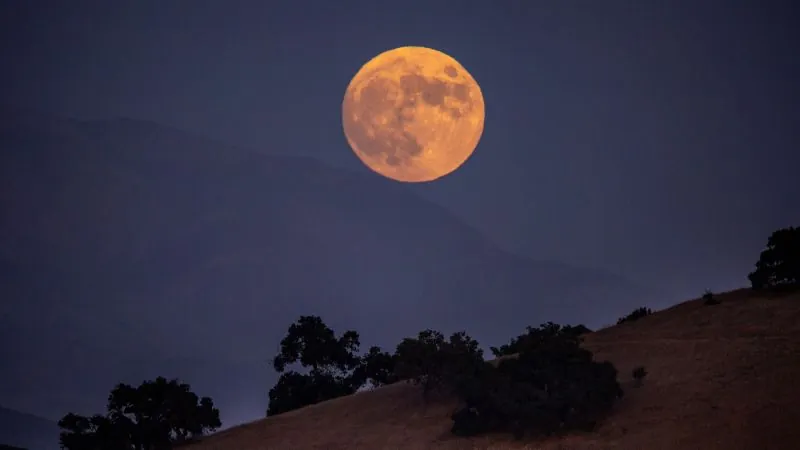
Catch the Spectacular Supermoon and Partial Lunar Eclipse this September: Here’s How!
2024-09-17
Exciting news for sky-gazers! This September, we are treated to a breathtaking celestial event featuring a full harvest supermoon accompanied by a partial lunar eclipse. Mark your calendars for this Tuesday night, when the moon will reach its peak fullness at 10:35 PM ET. However, do keep your eyes glued to the sky as the moon will appear full until Thursday morning.
On Tuesday evening, you can witness the magical moment when the moon seems to have a bite taken out of it, courtesy of a partial lunar eclipse. This mesmerizing phenomenon occurs when the Earth is positioned between the sun and the moon, but they are not perfectly aligned. Get ready to catch a view, especially if you’re in Europe, most of Asia, Africa, and the Americas!
The sequence is set to unfold as follows: the moon will enter Earth's shadow at 10:13 PM ET and exit it at 11:16 PM ET, with the peak of the eclipse occurring at 10:44 PM ET. Depending on your location, you’ll want to check local timings to not miss out, as visibility will vary from evening in the U.S. to early morning for viewers in Europe.
While total lunar eclipses turn the moon a fiery red, often dubbed a "blood moon," this event won’t exhibit that dramatic transformation. According to Noah Petro, a NASA project scientist, the upcoming eclipse will merely darken one small section of the moon, specifically the upper right corner. If you're looking closely, you might just notice the difference amidst the moon's overall glow!
September's full moon isn’t just any moon; it’s the second of four consecutive supermoons seen in 2024. Supermoons appear larger and brighter because they occur when the moon is closer to Earth. This month, the moon will glide by at approximately 222,637 miles (358,300 kilometers) away, compared to the average distance of 238,900 miles (384,472 kilometers).
Additionally, keep an eye out for Saturn shining like a brilliant star nearby the full moon.
Celebrating the Harvest Moon
The harvest moon earns its name from its significance at the onset of fall. This year, it coincides closely with the autumnal equinox, which occurs on September 22. Traditionally, this full moon has helped farmers complete their harvest before the first frost, shedding light on their evening labor.
In various cultures, September is known by several names. The Hopi people call it the "moon of full harvest," while the Abenaki tribe refers to it as the "corn maker moon." Native cultures across North America, such as the Lakota and Passamaquoddy, have other unique designations, celebrating the bounty of the harvest season. European names like the "fruit moon" and the "barley moon" reflect the ripening crops that characterize this time of year.
In addition, this time of year marks celebrations such as the Korean festival of Chuseok and the Chinese Mooncake Festival, both steeped in family gatherings and ancestral remembrance.
Look Ahead to More Astronomical Wonders!
Don’t put away your binoculars just yet! The next full moon, known as the hunter's moon, is set for October 17 and will be the closest full moon of the year at just 222,095 miles (357,428 kilometers) away. Following that, prepare for the beaver moon on November 15 and the cold moon on December 15 to round out the year.
Exciting meteor showers are also on the horizon, with peak dates including the Draconids (October 7-8), Orionids (October 20-21), and the much-anticipated Geminids (December 13-14).
Prepare for stellar nights ahead, as the cosmos has a thrilling lineup waiting just for you! Don't miss out on these celestial experiences—grab a blanket, your favorite refreshments, and settle in for an awe-inspiring evening under the stars!



 Brasil (PT)
Brasil (PT)
 Canada (EN)
Canada (EN)
 Chile (ES)
Chile (ES)
 España (ES)
España (ES)
 France (FR)
France (FR)
 Hong Kong (EN)
Hong Kong (EN)
 Italia (IT)
Italia (IT)
 日本 (JA)
日本 (JA)
 Magyarország (HU)
Magyarország (HU)
 Norge (NO)
Norge (NO)
 Polska (PL)
Polska (PL)
 Schweiz (DE)
Schweiz (DE)
 Singapore (EN)
Singapore (EN)
 Sverige (SV)
Sverige (SV)
 Suomi (FI)
Suomi (FI)
 Türkiye (TR)
Türkiye (TR)